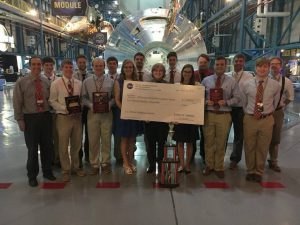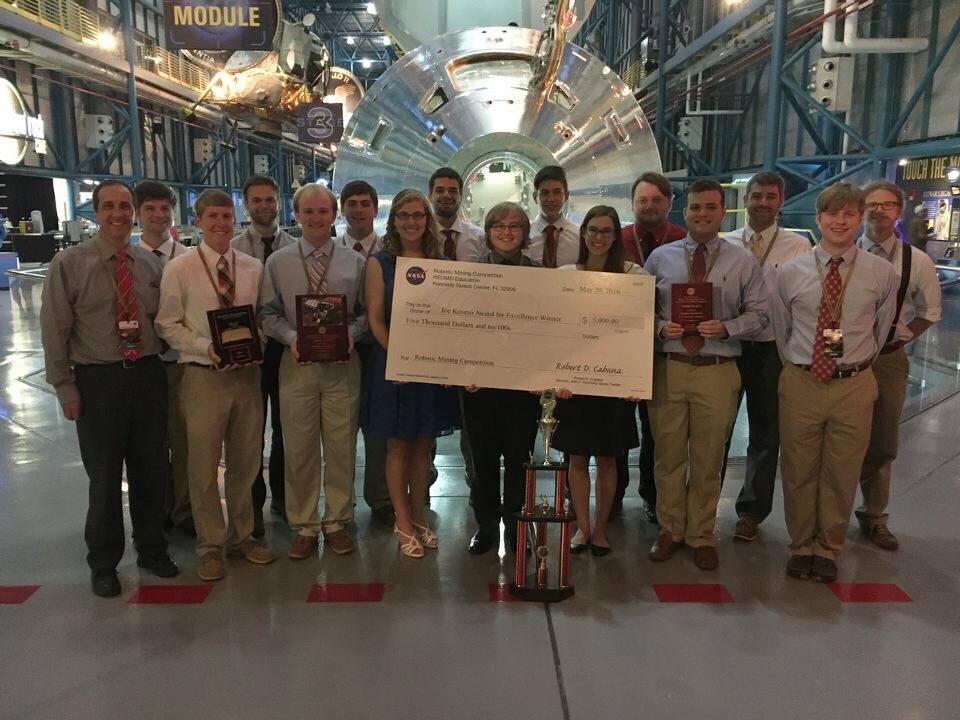
TUSCALOOSA, Ala. — A team of University of Alabama students won back-to-back championships this past weekend, cementing its status as the most successful team in the competition.
Alabama Astrobotics took top prize at the NASA Robotic Mining Competition, besting student teams from 45 other institutions in the challenge to build a robot capable of navigating and excavating simulated Martian soil.
Made up of students from across engineering disciplines, computer science and other areas of campus, along with students from Shelton State Community College, Alabama Astrobotics is now the only team to win the NASA contest in consecutive years. The team has won three times during the competition’s seven-year history.
Robots are judged not only on how much simulated soil they can dig and deposit into bins but also on their ability to operate on their own, or autonomously.
The robots are also judged on their size and weight, and Alabama Astrobotics built a robot that performed well in all three areas, said Dr. Kenneth Ricks, UA associate professor of electrical and computer engineering and team adviser.
“Every year the level of competition improves across the board,” Ricks said. “What separated the UA robot from the others is that it performed well in all three areas: digging and collecting; robot mass; and autonomy. That combination was unequaled by the competition.”
NASA invited 45 university teams to compete in the mining contest during the third week of May at the Kennedy Space Center in Florida. On May 20, the last night of the competition, NASA officials announced Alabama Astrobotics notched the most points in the competition, winning the Joe Kosmo Award for Excellence as the top overall team.
The team placed first in the categories of mining, autonomy and technical presentation. In all, the students won $10,000 for use on next year’s robot.
As part of the competition, students are required to design a robot capable of navigating through and excavating 10 kilograms of simulated Martian regolith, a layer of loose material that covers a solid rock.
The robot is allowed two competition runs of 10 minutes each to move across the arena, through an obstacle area, excavate as much regolith as possible, and return the collected regolith back to the starting area.
Like every year, the team designed and built a new robot. For this competition, however, the students kept the design from last year, improving some of its mining capabilities, making it lighter and upgrading its ability to operate on its own, said team lead Caleb Leslie, a graduate student in electrical engineering, before the start of the contest.
Improvements included changes to the robot’s programming, or algorithms, that control autonomy, and upgrading the sensors that scan the competition arena that allow the robot essentially to see its surroundings and navigate around them, Leslie said.
Alabama Astrobotics is made up of about 40 students and is advised by Ricks and Renea Randle, mathematics instructor at Shelton State.
As part of a required educational outreach component, members of Alabama Astrobotics have hosted outreach activities on campus during E-Day and game day tailgates. Additionally, the team has worked with students at University Place Elementary School in the Tuscaloosa City School System to introduce science and technology concepts through hands-on activities.
The team received funding from the Alabama Space Grant Consortium, NASA, Dynetics, Fitz-Thors Engineering, the UA College of Engineering, and the UA Student Government Association.
Contact
Adam Jones, engineering public relations, 205/348-6444, acjones12@eng.ua.edu
